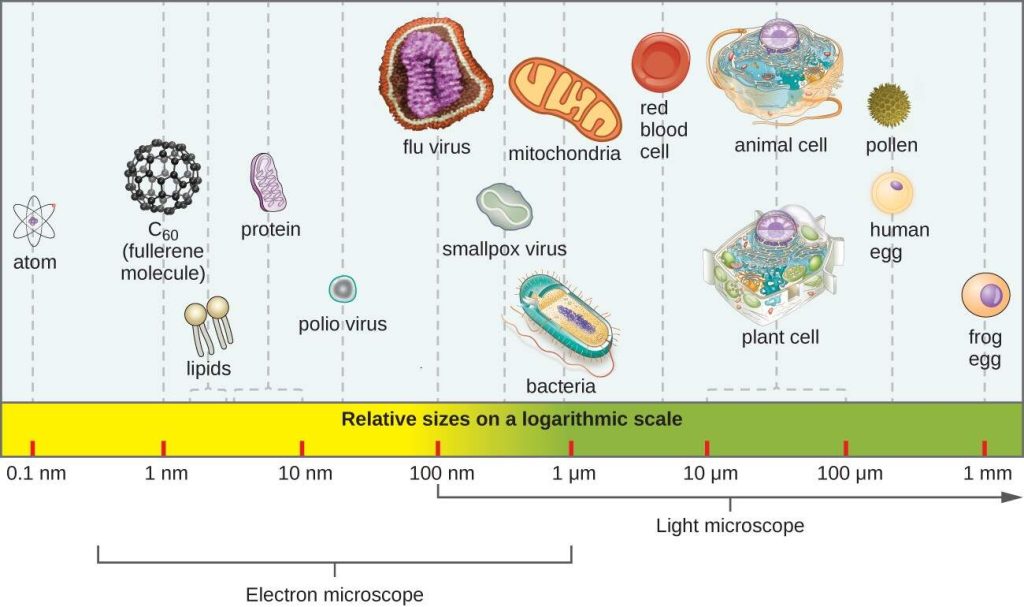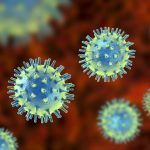Most microbes are unicellular and small enough that they require artificial magnification to be seen. However, there are some unicellular microbes that are visible to the naked eye, and some multicellular organisms that are microscopic. An object must measure about 100 micrometers (µm) to be visible without a microscope, but most microorganisms are many times smaller than that. For some perspective, consider that a typical animal cell measures roughly 10 µm across but is still microscopic. Bacterial cells are typically about 1 µm, and viruses can be 10 times smaller than bacteria (Figure 1). See Table 1 for units of length used in microbiology.

Figure 1. The relative sizes of various microscopic and nonmicroscopic objects. Note that a typical virus measures about 100 nm, 10 times smaller than a typical bacterium (~1 µm), which is at least 10 times smaller than a typical plant or animal cell (~10–100 µm). An object must measure about 100 µm to be visible without a microscope.
| Table 1. Units of Length Commonly Used in Microbiology | ||
| Metric Unit | Meaning of Prefix | Metric Equivalent |
| meter (m) | — | 1 m = 100 m |
| decimeter (dm) | 1/10 | 1 dm = 0.1 m = 10−1 m |
| centimeter (cm) | 1/100 | 1 cm = 0.01 m = 10−2 m |
| millimeter (mm) | 1/1000 | 1 mm = 0.001 m = 10−3 m |
| micrometer (μm) | 1/1,000,000 | 1 μm = 0.000001 m = 10−6 m |
| nanometer (nm) | 1/1,000,000,000 | 1 nm = 0.000000001 m = 10−9 m |
Microorganisms differ from each other not only in size, but also in structure, habitat, metabolism, and many other characteristics. While we typically think of microorganisms as being unicellular, there are also many multicellular organisms that are too small to be seen without a microscope. Some microbes, such as viruses, are even acellular (not composed of cells).
Microorganisms are found in each of the three domains of life: Archaea, Bacteria, and Eukarya. Microbes within the domains Bacteria and Archaea are all prokaryotes (their cells lack a nucleus), whereas microbes in the domain Eukarya are eukaryotes (their cells have a nucleus). Some microorganisms, such as viruses, do not fall within any of the three domains of life. In this section, we will briefly introduce each of the broad groups of microbes. Later chapters will go into greater depth about the diverse species within each group.
Prokaryotic Microorganisms
Bacteria are found in nearly every habitat on earth, including within and on humans. Most bacteria are harmless or helpful, but some are pathogens, causing disease in humans and other animals. Bacteria are prokaryotic because their genetic material (DNA) is not housed within a true nucleus. Most bacteria have cell walls that contain peptidoglycan.
Bacteria are often described in terms of their general shape. Common shapes include spherical (coccus), rod-shaped (bacillus), or curved (spirillum, spirochete, or vibrio). Figure 2 shows examples of these shapes.

Figure 2. Common bacterial shapes. Note how coccobacillus is a combination of spherical (coccus) and rod-shaped (bacillus). (credit “Coccus”: modification of work by Janice Haney Carr, Centers for Disease Control and Prevention; credit “Coccobacillus”: modification of work by Janice Carr, Centers for Disease Control and Prevention; credit “Spirochete”: Centers for Disease Control and Prevention)
They have a wide range of metabolic capabilities and can grow in a variety of environments, using different combinations of nutrients. Some bacteria are photosynthetic, such as oxygenic cyanobacteria and anoxygenic green sulfur and green nonsulfur bacteria; these bacteria use energy derived from sunlight, and fix carbon dioxide for growth. Other types of bacteria are nonphotosynthetic, obtaining their energy from organic or inorganic compounds in their environment.
Archaea are also unicellular prokaryotic organisms. Archaea and bacteria have different evolutionary histories, as well as significant differences in genetics, metabolic pathways, and the composition of their cell walls and membranes. Unlike most bacteria, archaeal cell walls do not contain peptidoglycan, but their cell walls are often composed of a similar substance called pseudopeptidoglycan. Like bacteria, archaea are found in nearly every habitat on earth, even extreme environments that are very cold, very hot, very basic, or very acidic (Figure 3). Some archaea live in the human body, but none have been shown to be human pathogens.

Figure 3. Some archaea live in extreme environments, such as the Morning Glory pool, a hot spring in Yellowstone National Park. The color differences in the pool result from the different communities of microbes that are able to thrive at various water temperatures.


